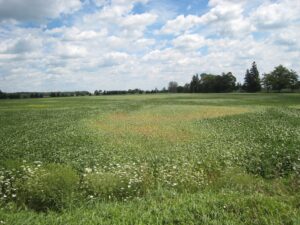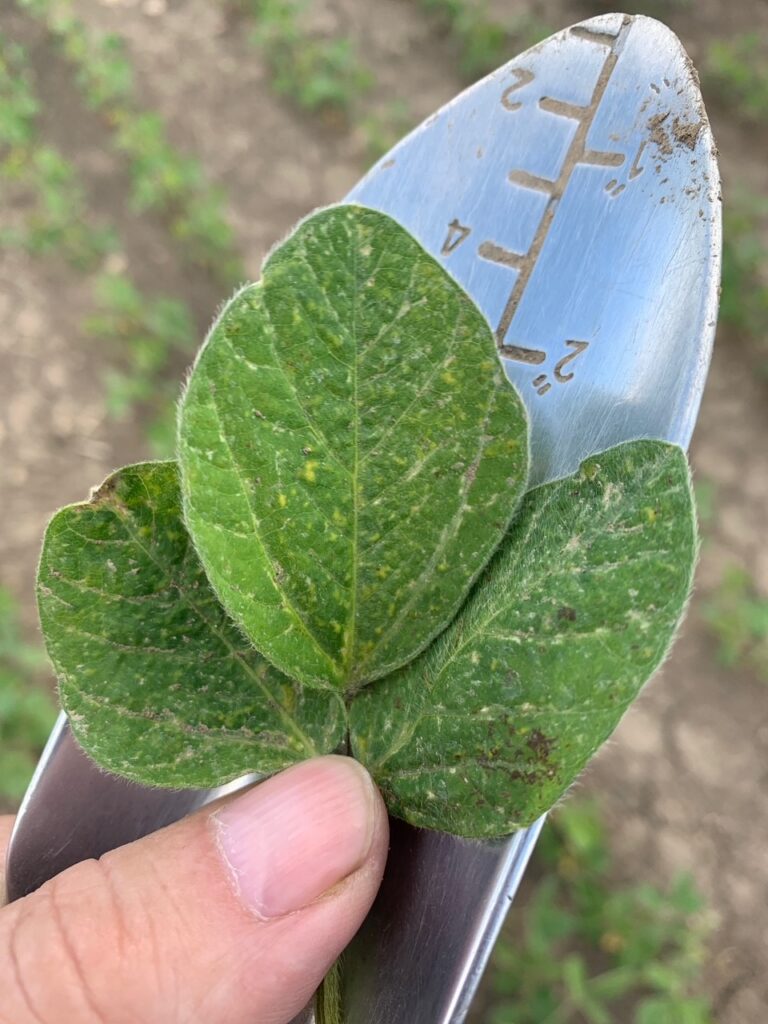It is proving to be another good insect year with several early season pests keeping everyone busy scouting to stay ahead of. Going into July and August, there are a few more pests that we need to keep watch for.
Thrips continue to be spotted in soybeans, corn and wheat fields. There are several different kinds of thrips that feed on many crops every year but tend to hang out on the lower leaves and go unnoticed (Figure 1.). They usually only progress further up the plants under stressful situations, especially in drought conditions or on nutrient deficient plants (Figure 2.). There are not many crops with thrip thresholds and those that exist are mainly for early vegetative stages, as is the case for soybeans. Research has not found thrips to cause economic damage worthy of an insecticide application in most situations. Rain is what these plants really need to alleviate the stresses that enable the thrips to thrive and will help the plants grow ahead of any thrip feeding.


Soybean aphids (SBA) have been found in a few early planted fields across Ontario but this doesn’t mean they will be an issue this year. It has been several years since we have had a bad SBA year with many acres requiring control. This is mainly due to natural enemies having learned to look for them in soybeans. Thanks to these natural enemies, we now only experience SBA on occasion in Ontario. Early planted fields are always colonized first from SBA that overwintered on nearby buckthorn or from those carried in on storm fronts from the U.S. These start up as pockets of several hundred aphids per plant. but soon spread out across the field and dilute to much lower numbers per plant. These diluted populations are easily cleaned off by natural enemies. Eventually, populations start to move to other fields and prefer later planted fields that are in earlier reproductive (R stages) and have longer to go before harvest (Figure 3.).

The threshold for soybean aphids is only valid for the R1 to R5 stages of soybeans as research has found no yield benefit to spraying in the vegetative stages. Spraying in the V stages can set the field up for requiring a second spray because the natural enemies were wiped out. An application is warranted in the R1 to R5 if there are 250 aphids per plant on 80% of the plants and populations continue to climb. This threshold gives an approximate 7 to 10-day lead time before the aphids would reach the economic injury level (~600 aphids per plant), where cost of control is equal to yield loss.
A spray decision requires at least two scouting trips to see if aphid populations are fluctuating above and below 250 (i.e. natural enemies are staying ahead of them) or if aphid numbers are steadily increasing. In stressed fields when plants are shorter than usual, spray closer to 250 to 300 aphids per plant, while in healthy fields, spraying can be delayed until closer to 500 aphids per plant. To help you make a spray decision use the free Aphid Advisor app (www.aphidapp.com). Enter the crop stage, level of aphids you are seeing, and the number of different natural enemies present, and the app will do the rest. The app then takes into consideration the weather forecast for the next 7 days and calculates the aphid reproduction rate expected versus the consumption rates of the natural enemies’ present. Products registered for soybean aphids are listed in the Field Crop Protection Guide.
Spider mites could be an issue this year in soybeans and dry beans, given dry conditions and likely early wheat harvest (Figure 4.). More concerning is the confirmation of a few cases of dimethoate resistance in Ontario last year. Through a project with AAFC-London and Western University, we are looking to take samples of spider mites before and after applications of dimethoate (Cygon or Lagon) to determine the extent of this resistance. Given dimethoate is the only active ingredient registered for these crops, we also want to test their susceptibility on other products in lab to determine what still works and is worth pursuing for registration. Please contact Tracey Baute, OMAFRA Entomologist-Field Crops at (tracey.baute@ontario.ca) if you find spider mites in fields this summer. More information on how to scout for spider mites can be found on Field Crop News: https://fieldcropnews.com/2020/07/spidermites-are-thriving-in-2020-be-vigilant/

A new corn rootworm adult trap network has been initiated by OMAFRA and Iowa State University with several partners to monitor for this pest across much of the US and Canada. Sticky traps in continuous corn fields will be monitored weekly for six to eight weeks for both western and northern corn rootworm to identify potential fields that require further scouting for potential Bt resistance. GFO and OMAFRA have provided funding for trap supplies and we are still looking for more trap participants and field sites. Contact Tracey Baute (tracey.baute@ontario.ca) if you are interested. More information on the rootworm trap network and what is involved in trapping is available here: https://fieldcropnews.com/2021/05/introducing-the-new-adult-corn-rootworm-trap-network-trap-participants-needed/
Weather Data
| Location |
Year |
Weekly June 14 – 20 | Accumulated | ||||||
| Highest Temp (°C) | Lowest Temp (°C) | Rain (mm) | Rain (mm) April 1st | GDD 0C April 1st | GDD 5C April 1st | CHU May 1st | |||
| Harrow | 2021 | 30 | 9 | 53 | 186 | 1142 | 755 | 970 | |
| 2020 | 30 | 9 | 0 | 169 | 995 | 621 | 916 | ||
| 2019 | 23 | 10 | 13 | 311 | 986 | 599 | 816 | ||
| Ridgetown | 2021 | 30 | 6 | 24 | 145 | 1068 | 690 | 916 | |
| 2020 | 30 | 7 | 0 | 153 | 925 | 566 | 862 | ||
| 2019 | 25 | 10 | 18 | 270 | 937 | 552 | 775 | ||
| London | 2021 | 28 | 4 | 13 | 142 | 1059 | 686 | 888 | |
| 2020 | 30 | 7 | 11 | 191 | 886 | 530 | 796 | ||
| 2019 | 22 | 10 | 22 | 286 | 811 | 462 | 665 | ||
| Brantford | 2021 | 30 | 5 | 9 | 129 | 1042 | 668 | 872 | |
| 2020 | 31 | 5 | 1 | 144 | 877 | 526 | 779 | ||
| 2019 | 26 | 10 | 1 | 274 | 855 | 493 | 718 | ||
| Welland | 2021 | 28 | 6 | 8 | 93 | 1034 | 655 | 860 | |
| 2020 | 31 | 6 | 0 | 141 | 910 | 552 | 818 | ||
| 2019 | 27 | 10 | 29 | 280 | 917 | 539 | 768 | ||
| Elora | 2021 | 27 | 4 | 22 | 119 | 950 | 585 | 791 | |
| 2020 | 29 | 5 | 3 | 134 | 803 | 471 | 715 | ||
| 2019 | 25 | 8 | 17 | 288 | 778 | 425 | 657 | ||
| Mount Forest | 2021 | 27 | 4 | 1 | 103 | 959 | 596 | 808 | |
| 2020 | 29 | 6 | 5 | 151 | 793 | 473 | 719 | ||
| 2019 | 24 | 7 | 129 | 759 | 415 | 640 | |||
| Peterborough | 2021 | 27 | 4 | 15 | 106 | 942 | 566 | 781 | |
| 2020 | 30 | 3 | 0 | 128 | 802 | 461 | 724 | ||
| 2019 | 26 | 5 | 3 | 276 | 781 | 423 | 641 | ||
| Kingston | 2021 | 29 | 8 | 18 | 116 | 964 | 588 | 781 | |
| 2020 | 29 | 4 | 0 | 168 | 878 | 515 | 782 | ||
| 2019 | 25 | 8 | 18 | 279 | 862 | 488 | 708 | ||
| Kemptville | 2021 | 28 | 8 | 44 | 142 | 1056 | 673 | 864 | |
| 2020 | 32 | 4 | 0 | 126 | 844 | 492 | 757 | ||
| 2019 | 27 | 7 | 15 | 203 | 801 | 444 | 647 | ||
| Earlton | 2021 | 30 | 4 | 0 | 85 | 892 | 536 | 720 | |
| 2020 | 33 | 1 | 8 | 120 | 652 | 382 | 622 | ||
| 2019 | 23 | 5 | 18 | 288 | 564 | 276 | 485 | ||
| Sudbury | 2021 | 25 | 5 | 4 | 128 | 909 | 553 | 748 | |
| 2020 | 31 | 2 | 0 | 120 | 699 | 405 | 656 | ||
| 2019 | 22 | 7 | 4 | 252 | 547 | 265 | 442 | ||
| Thunder Bay | 2021 | 30 | 5 | 6 | 210 | 765 | 422 | 651 | |
| 2020 | 29 | 3 | 0 | 77 | 617 | 343 | 589 | ||
| 2019 | 25 | 2 | 1 | 148 | 475 | 200 | 378 | ||
| Fort Frances | 2021 | 28 | 4 | 5 | 151 | 826 | 478 | 755 | |
| 2020 | 33 | 5 | 36 | 148 | 738 | 436 | 714 | ||
| 2019 | 25 | 4 | 8 | 129 | 597 | 292 | 500 | ||
| Report compiled by OMAFRA using Environment Canada data. Data quality is verified but accuracy is not guaranteed. Report supplied for general information purposes only. An expanded report is available at www.fieldcropnews.com. | |||||||||
